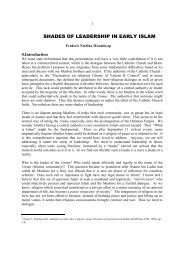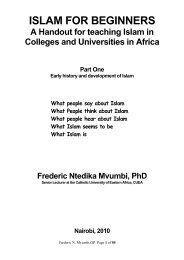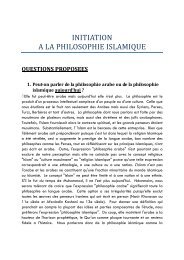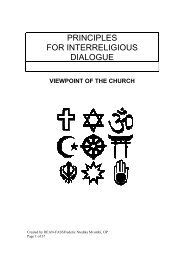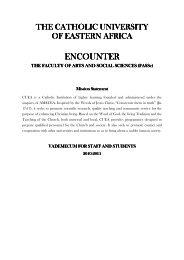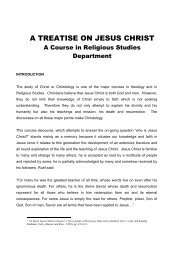INTRODUCTION TO ISLAMIC THEOLOGY.pdf - CUEA
INTRODUCTION TO ISLAMIC THEOLOGY.pdf - CUEA
INTRODUCTION TO ISLAMIC THEOLOGY.pdf - CUEA
You also want an ePaper? Increase the reach of your titles
YUMPU automatically turns print PDFs into web optimized ePapers that Google loves.
3the religion founded by Muhammad, 3 was as well influenced by several previous monotheisticideas expressed either implicitly or explicitly. In short, the religious thought of pre-Islamic Arabiaand the rest of the Middle East can be compared with Islamic monotheism.Pre-Islamic Arabian thoughtMuslims refer to Arabian culture before the birth of Muhammad as jâhiliyyah. In fact,zthe term Jahiliyyah, usually rendered time of ignorance or barbarism, in reality means theperiod in which Arabia had no dispensation, no inspired prophet, no revealed book; forignorance and barbarism can hardly be applied to such a cultured and lettered society asthat developed by the south Arabians. 4Thus, it is advisable for us to examine the religious situation of that period for a betterunderstanding of Islamic monotheism. Before that, let us look at how the geographical and culturalsituation led Arabians to focalise their thinking to a spiritual life.Geographical and Cultural situationThe land of Arabia determines in one way or the other the cultural and religious situation of thecountry. In other words the position of Arabia influences its culture, and culture goes with religion.Arabia is a peninsula, which is divided into two main parts: the north and the south. Both of themare covered by the Arabian Desert. Because of the desert, any organization based on fixeddwellings was impossible especially in the north where Bedouins lived. P.M. Holt observes: “TheBedouins of the desert and the sedentarized nomads of the oases are two main representatives ofthe arid area dwellers in the north. 5The south, different from the north because of its favourite climate, had an advanced civilizationbased on agriculture. 6In spite of this distinction, both northerners and southerners were submitted to desert law whichinfluenced them in all their thoughts, needs and deeds. That is why they were animist. The maintowns (Makka, â'if and Medina) followed the same law. The Arabians believed that inanimateobjects, such as trees, stones and springs, housed spirits which could influence the lives of men. 7In anything they did or thought, Arabians bore in their mind not only the presence but also theinfluence of spirits. Taylor says that animism, so defined, was the core of all religions. Accordingto him, the term "spirits" applies to gods and divinities. 8 Arabia was not exempted from this3 Robert Caspar, "The permanent signification of Islam's monotheism," in Concilium.Religion in the eighties (Edimburgh: T. and T. Clark Ltd, 1985), pp. 67-78.4 Philip Hitti, History of the Arabs, from the earliest times to the present (London:Macmillan, 9th ed. 1968), p. 87.5 P.M. Holt (ed.), The Cambridge history of Islam, vol. 1, The central Islamic lands,(Cambridge: University Press, 1970), p. 5.6 Carl Brockelman, History of the islamic peoples, (New York: Capricorn books), 1960),p. 582.7 Philip Hitti K, op. cit., p. 15.8 Philip Hitti, "Arabia" in The Encyclopedia Americana, (New York: AmericanaCorporation, vol 1, 1927).




